Lunt LS60THa/B1200
By Antony McEwan
Catchy title, huh? So what on Earth’s a Lunt? And what’s a B1200? And what’s ‘Tha’ all about? Well, if you’re at all into solar observing you may know the answers to some of these questions at least. Since I now own the above telescope, I’ll try to fill you in on the rest too, and let you know what I think of it.
Lunt is a fairly new company, owned by one Andrew Lunt, a former employee of Coronado. Coronado is one of the biggest makers of hydrogen alpha telescopes, and was the company that launched the groundbreaking Personal Solar Telescope, or PST. The PST brought hydrogen alpha observing of our Sun to the masses.
The LS60 part of the name describes the ‘scope in question as a Lunt Systems 60mm aperture ‘scope. Tha refers to Telescope Hydrogen alpha (as opposed to Calcium K, another popular way of viewing the Sun). B1200 refers to the type of blocking filter (built into the diagonal) used in the telescope. 1200 shows that the filter gives a 12mm clear aperture. Others in the range are 600 (6mm), 1800 (18mm), etc.
Observing our Sun in the hydrogen alpha wavelength, means that you can actually look at the Sun’s Chromosphere and features contained therein. These include prominences (outpourings of solar material, seen at the limb against a background of space), filaments (prominences shown against the solar disc), spicules (short-lived columns of solar material that rise along magnetic field lines) and plages (bright ‘clouds’ of material associated with Sunspots).
These features provide observers with exciting views that change over short periods of time, providing a very dynamic observing experience. By contrast, ‘traditional’ views of the Sun using a ‘white light’ filter allow us to see Sunspots directly, granulation and faculae – features of the photosphere rather than the chromosphere. So the two different observing techniques allow us to see different portions of the Sun’s atmosphere, and therefore different features.
My Ha History
A while ago I bought a PST and used it for about a year. I sold it after that to help fund a large APO. The PST introduced me to these dynamic hydrogen alpha features such as filaments, proms and active regions, and viewing with it was very rewarding. However, there were some issues with it. The PST did not have a proper focuser, only a single, small screw to adjust the focus. Even using this to its extremes could not get some of my eyepieces to focus and I had to pull them half out of the eyepiece holder to get them focused. So that was a practical issue. The other issue I had with it was more aesthetic. It just didn’t feel like a proper telescope. The lack of a proper focuser definitely contributed to that of course.
Despite this, after selling it on I began to miss the chances to view the Sun in hydrogen alpha, so I began researching a follow-up Ha telescope and discovered the fairly new Lunt brand. When I first followed an Internet link I was shown a picture of a classy-looking black and white coloured tube assembly with a two speed Crayford focuser, a proper-looking diagonal arrangement, and a TeleVue-ish clamshell for mounting purposes! Surely not! A hydrogen alpha telescope that looks like a real refractor? The telescope uses a single element in its objective lens, and has a focal length of 500mm. The extra glass of a doublet is not required, as correction of false colour is not needed for hydrogen alpha viewing.
The prices for these Lunt ‘scopes are not low. They come in 35mm, 60mm and 100mm aperture refractor styles, and even a yet-to-be-delivered 200mm modified Newtonian tube! The 35mm is priced about the same as the PST and the 60mm model comes in at around the £1200 mark, depending on which blocking filter (B1200, B600, etc, remember?) you get packaged with the tube assembly. The B1200’s are more expensive than the B600’s, by about £100 or so, and the B1800’s are more expensive than the B1200’s – you get the picture.
Not surprisingly, I started looking around for a ‘bargain’ and within a few weeks found two second hand models up for sale! The first, a B600 version, I let slip by, but the B1200 model was irresistible and I purchased it for a few hundred pounds less than the new retail price. I had decided the B1200 blocking filter would be preferable because it gives a larger clear area in the field of view, so the Sun’s disc will be framed by more space. This is very handy when using the ‘scope on a non-driven alt-az mount, as the disc will take longer to drift across the field of view than in the B600 model.
The Telescope
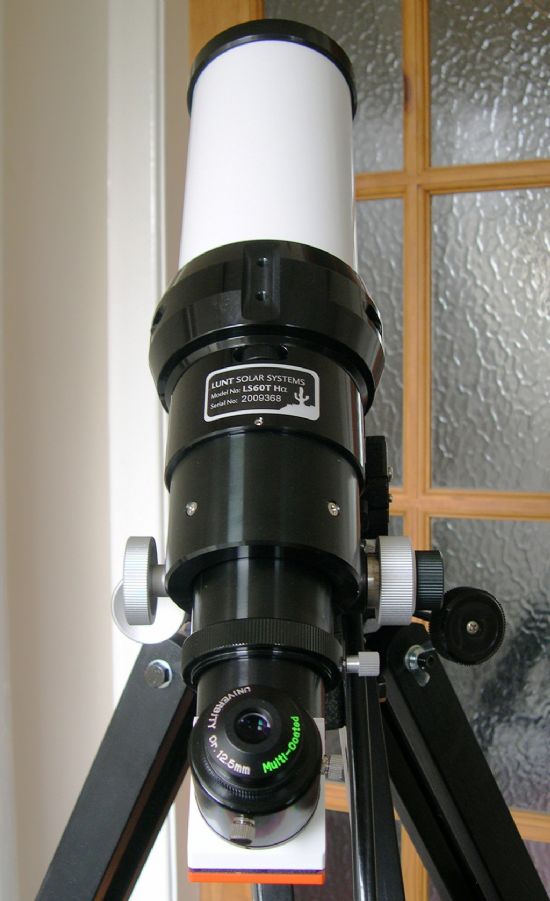 The ‘scope duly arrived, packed in its custom aluminium case as expected, in excellent condition. A trifle dusty, but then it was unused since being bought and the dust blew off so no problem! My first impression was the build quality and the weight. It weighs in at 6lb, a tad less than my ED80, though it is physically much smaller. The materials are all excellent and there are no scratches, blemishes or marks anywhere on the tube assembly. Everything feels very well put together and smooth, and did I mention it looks and feels like a real telescope? The focuser is the standard two-speed Crayford option, with a 10:1 reduction for fine focusing. Lunt can also supply a Feathertouch focuser on their telescopes, which costs a little more but is recommended for holding heavy photographic equipment or for the ultimate in deluxe focusing enjoyment.
The ‘scope duly arrived, packed in its custom aluminium case as expected, in excellent condition. A trifle dusty, but then it was unused since being bought and the dust blew off so no problem! My first impression was the build quality and the weight. It weighs in at 6lb, a tad less than my ED80, though it is physically much smaller. The materials are all excellent and there are no scratches, blemishes or marks anywhere on the tube assembly. Everything feels very well put together and smooth, and did I mention it looks and feels like a real telescope? The focuser is the standard two-speed Crayford option, with a 10:1 reduction for fine focusing. Lunt can also supply a Feathertouch focuser on their telescopes, which costs a little more but is recommended for holding heavy photographic equipment or for the ultimate in deluxe focusing enjoyment.
The clamshell ring supplied looks very similar to the one I had on my old TeleVue 85 – I wonder if they’re made in the same factory? It doesn’t have the quick-release bolts with the turning blades at the tops though, meaning that you have to employ an Allen key to loosen the bolts if you wish to rotate the tube within the ring.
Despite the weight, the tube is very compact, and is therefore easy to mount. It attaches to my modified AZ-3 alt-az mount using a 1/4x20 attachment screw with no problems, and also sits on my driven SupaTrak alt-az mount by attaching a dovetail plate to the clamshell.
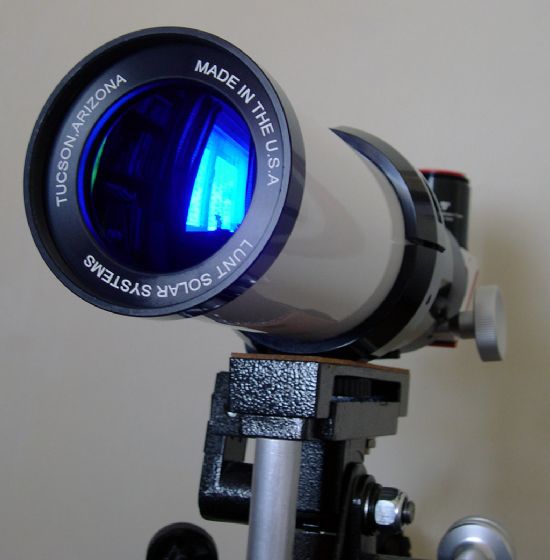 |
| Nice build quality and materials. Sits nicely on AZ-3 |
The lens cover is a screw-in affair, made of metal, with a wide threaded section. It takes quite a while to unscrew it! This is very welcome though and is reassuring. The lens revealed when the cover is removed is quite stunning. Not being very experienced in examining hydrogen alpha telescopes, I wasn’t really sure what to expect but the lens looks to be perfect, with a bright blue sheen to it. Inside the tube, you can see the internal etalon halfway down the tube. This is the tuning element that allows the user to fine-tune the wavelength of light that is shown at the eyepiece. In some positions prominences are more obvious, in others, filaments, etc. The ability to fine-tune the wavelength makes the ‘scope quite versatile, and allows for different features to be viewed at their best visibility within the wavelength that is transmitted.
Examining the ‘scope in close detail, I noticed within the tube that the mounting ring of the etalon had what looked like some excess glue or something similar around its edge. It was not on the important aperture of the etalon itself, but I emailed the Support team at Lunt to find out if I should be concerned about it. Within 24 hours I had a reply saying that it was probably some excess silicone used in the construction process and that it was nothing to worry about. I was impressed.
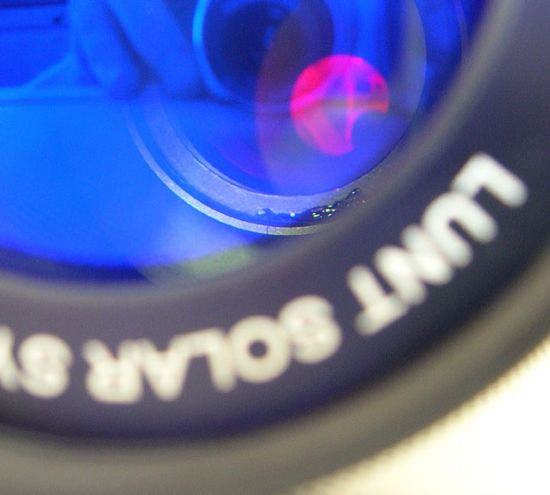 |
| The excess silicone shown on the etalon mounting plate - so far completely unproblematic |
Indeed, over the first couple of weeks of ownership, I made several enquiries of Lunt by email, and every single one was answered within one working day, even at the weekend! Indeed, in some cases they didn’t just answer my enquiry but provided me with further reading on the topic to help me understand the issue in question. Customer support like that will certainly help Lunt become a leading force in hydrogen alpha observing, but what of the ‘scope itself? How did it fare…
Here Comes The Sun
Initial views took plce with the ‘scope mounted on my modified AZ-3 alt-az mount. The sky was clear, but had some high haze. The view when I finally managed to find the Sun (harder than you think without a proper solar finderscope of some kind) showed a bright orange-red disc covered in stippled detail. As it happens, the tuning mechanism was set just perfectly to show off the couple of prominences that were visible at that time. The view was sharp. Not fuzzy or vague, but really sharp and bright. It felt, even at that time, like I was using a proper telescope. The focuser worked like a proper focuser, and the fine focus was very responsive and worked a treat.
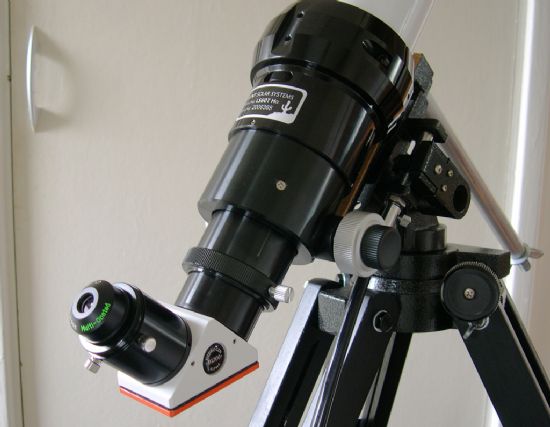 | |
| The hands-on end, complete with smooth 2-speed Crayford focuser |
I started off by using simple orthoscopic eyepieces for maximum light transmission. I used a 25mm (20x), 18mm (28x), 12.5mm (40x) and 9mm (55x). All the eyepieces showed the same high quality view. I centred the biggest prom and went through the magnifications, and noticed that the detail shown remained visible with each change and just became larger with each increase in power! The sharpness of the view remained constant too, making it a pleasure to compare the views between low and high power. I have to say, the high haze in the sky made the background appear a milky washed-out reddish colour, not the black I was expecting. Some reading on the astronomy forums showed that other Lunt users had made the same observation of the sky colour not being black. However, a few days later I was able to observe again, with a truly clear sky and no apparent haze. This time the sky background was jet black and the contrast between the Sun’s limb and the sky was intense and razor sharp.
I should point out perhaps that hydrogen alpha observing is perhaps not as simple a procedure as nighttime observing. Any stray light at the eyepiece becomes problematic very quickly, reducing visible contrast noticeably. A slight reduction in this contrast can be enough to make the feature under observation completely invisible. Therefore, some means of blocking out stray light has to be employed. I use a black towel over the head and it works very well too. Not only that, but it feels great being off in my own little hydrogen alpha world, hidden away from the stresses and strains of everyday life…
As well as the AZ-3 mount, I bought a Skywatcher SupaTrak mount for the Lunt. It’s a driven single arm alt-az mount and is perfectly adequate for small telescopes (up to 127mm Maksutov size and weight). It provides perfectly reasonable tracking performance with the Lunt attached, and it is very handy not having to manually adjust the scope to bring the Sun back into view as it drifts across. I added slightly sturdier tripod legs, but otherwise haven’t had to do much to the mount. I run it off the provided battery pack for ease of set-up and use.
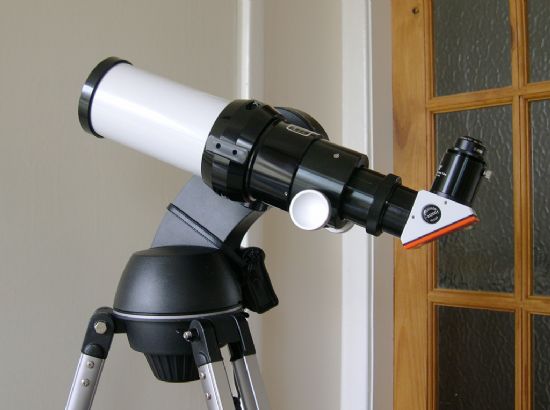 |
| The Skywatcher SupaTrak mount is ideal - portable and with built-in tracking |
I did notice some peculiarities when using the Lunt. One is well known to the PST-using community as the Sweet Spot. This is an effect where one portion of the field of view shows a higher contrast, clearer view than the other portions. It is very obvious on the PST. In the Lunt, I have only come across it on two occasions. Both occurred when using low magnification viewing the entire solar disc. In these cases, the lower half of the field of view showed considerable detail, but when I repositioned the Sun so that it was in the upper half, the detail disappeared and the disc became entirely bland. An email was sent to Lunt, and the reply (same day) advised me that this was a normal side effect of the use of internal etalons within the Lunt ‘scopes. They also stated that they make every effort to adjust the etalon position within the telescopes so as to make the effect as minimal as possible. Indeed, when increasing the magnification so that the disc takes up more space within the field of view, the effect diminishes greatly, and when employing enough magnification that only a portion of the solar disc is visible at one time, the effect is removed completely. I suspect that the position of the etalon tuning may also have an effect.
Compared with my memory of the PST, where only one quadrant of the field of view showed a truly sharp, contrasty view, the Lunt shows a huge improvement. Speaking of magnification, after a while I began to think about trying my more complex eyepieces instead of the Orthscopics, and to wonder about the maximum magnification that I could use effectively. I started off by using my Vixen LVW 22mm, Pentax XL 14mm and XL 10.5mm. The results were fantastic! The Pentaxes in particular showed extremely sharp views at 36x and 47x, with their wide 65-degree apparent field of view giving plenty of space to frame the solar disc even at their higher magnifications. Next one to try was my Meade Series 4000 8.8mm Ultra Wide Angle. The 8.8mm gave 57x and the view was still sharp and clear. My 6.7mm Ultra Wide Angle was next, giving 74x – and the view was still excellent! I used this eyepiece to zoom in on some obvious prominences that were visible and the detail within the proms was quite obvious, with smaller detached sections becoming apparent at the higher magnification and other small wispy bits being revealed within the main structures.
I haven’t gone any higher yet, but am confident that the ‘scope is quite capable of it, if the seeing conditions allow. I am not going to limit myself to Orthscopics with this ‘scope, despite the general advice to use simpler eyepiece designs with hydrogen alpha telescopes. The idea is that every piece of glass in the optical train reduces the light transmission somewhat, so simple eyepieces with only four elements (such as Orthscopics) will reduce that transmission by less than complex 7 or 8 element glass grenades. However, in my experience so far, the views through the more complicated eyepieces have given nothing up compared with their simple orthoscopic brethren.
Conclusion
So, the telescope shows a bright high contrast image, alive with detail. The focuser works perfectly and is very responsive. The tube assembly is well built and solid, with a feel somewhere between a William Optics and TeleVue ‘scope. The fittings are high quality, and the whole viewing experience is that of using a ‘proper telescope’. Have I missed anything?
Well, I did add a TeleVue Sol-Searcher solar finder to the clamshell ring to make it easier to find the Sun in the first place. I do find the tuning ring mechanism a little bit stiff, making the view wobble on the mount when I adjust it. I hope that it loosens up a little in time and with use. Other than that it works well and is a joy to use. I’m really looking forward to when the Sun finally begins to re-emerge from its dormant slumber of the past few years.